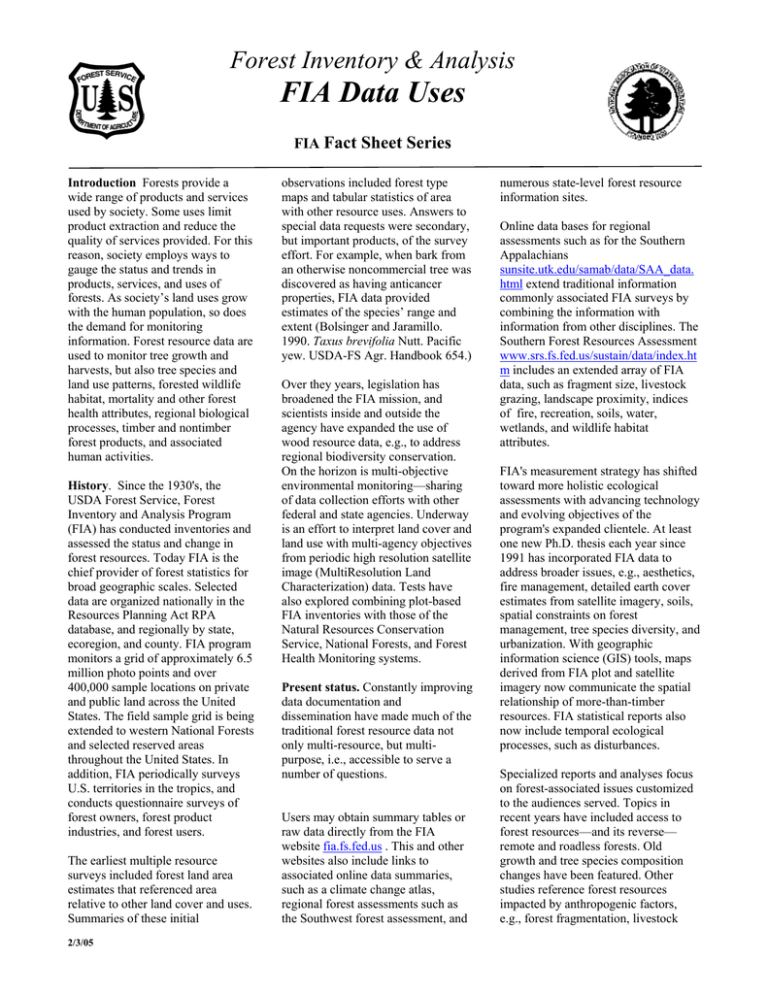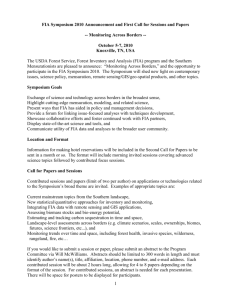FIA Data Uses Forest Inventory & Analysis Fact Sheet Series
advertisement

Forest Inventory & Analysis FIA Data Uses FIA Fact Sheet Series Introduction Forests provide a wide range of products and services used by society. Some uses limit product extraction and reduce the quality of services provided. For this reason, society employs ways to gauge the status and trends in products, services, and uses of forests. As society’s land uses grow with the human population, so does the demand for monitoring information. Forest resource data are used to monitor tree growth and harvests, but also tree species and land use patterns, forested wildlife habitat, mortality and other forest health attributes, regional biological processes, timber and nontimber forest products, and associated human activities. History. Since the 1930's, the USDA Forest Service, Forest Inventory and Analysis Program (FIA) has conducted inventories and assessed the status and change in forest resources. Today FIA is the chief provider of forest statistics for broad geographic scales. Selected data are organized nationally in the Resources Planning Act RPA database, and regionally by state, ecoregion, and county. FIA program monitors a grid of approximately 6.5 million photo points and over 400,000 sample locations on private and public land across the United States. The field sample grid is being extended to western National Forests and selected reserved areas throughout the United States. In addition, FIA periodically surveys U.S. territories in the tropics, and conducts questionnaire surveys of forest owners, forest product industries, and forest users. The earliest multiple resource surveys included forest land area estimates that referenced area relative to other land cover and uses. Summaries of these initial 2/3/05 observations included forest type maps and tabular statistics of area with other resource uses. Answers to special data requests were secondary, but important products, of the survey effort. For example, when bark from an otherwise noncommercial tree was discovered as having anticancer properties, FIA data provided estimates of the species’ range and extent (Bolsinger and Jaramillo. 1990. Taxus brevifolia Nutt. Pacific yew. USDA-FS Agr. Handbook 654.) Over they years, legislation has broadened the FIA mission, and scientists inside and outside the agency have expanded the use of wood resource data, e.g., to address regional biodiversity conservation. On the horizon is multi-objective environmental monitoring—sharing of data collection efforts with other federal and state agencies. Underway is an effort to interpret land cover and land use with multi-agency objectives from periodic high resolution satellite image (MultiResolution Land Characterization) data. Tests have also explored combining plot-based FIA inventories with those of the Natural Resources Conservation Service, National Forests, and Forest Health Monitoring systems. Present status. Constantly improving data documentation and dissemination have made much of the traditional forest resource data not only multi-resource, but multipurpose, i.e., accessible to serve a number of questions. Users may obtain summary tables or raw data directly from the FIA website fia.fs.fed.us . This and other websites also include links to associated online data summaries, such as a climate change atlas, regional forest assessments such as the Southwest forest assessment, and numerous state-level forest resource information sites. Online data bases for regional assessments such as for the Southern Appalachians sunsite.utk.edu/samab/data/SAA_data. html extend traditional information commonly associated FIA surveys by combining the information with information from other disciplines. The Southern Forest Resources Assessment www.srs.fs.fed.us/sustain/data/index.ht m includes an extended array of FIA data, such as fragment size, livestock grazing, landscape proximity, indices of fire, recreation, soils, water, wetlands, and wildlife habitat attributes. FIA's measurement strategy has shifted toward more holistic ecological assessments with advancing technology and evolving objectives of the program's expanded clientele. At least one new Ph.D. thesis each year since 1991 has incorporated FIA data to address broader issues, e.g., aesthetics, fire management, detailed earth cover estimates from satellite imagery, soils, spatial constraints on forest management, tree species diversity, and urbanization. With geographic information science (GIS) tools, maps derived from FIA plot and satellite imagery now communicate the spatial relationship of more-than-timber resources. FIA statistical reports also now include temporal ecological processes, such as disturbances. Specialized reports and analyses focus on forest-associated issues customized to the audiences served. Topics in recent years have included access to forest resources—and its reverse— remote and roadless forests. Old growth and tree species composition changes have been featured. Other studies reference forest resources impacted by anthropogenic factors, e.g., forest fragmentation, livestock grazing, owner parcelization, population density, and urban development. On sampled plots, survey observations include nonwood attributes, such as distance from nonforest cover, evidence of human uses, invasive species, and nontimber forest products. Owner surveys commonly combine forest land estimates with owners’ other resource production intentions. Exploratory studies are also underway to assess the growing market for nontimber forest products, such as ginseng. Collaboration. Policy makers, forest industry consultants, researchers, and managers alike take advantage of the data to depict the status and change in forests relative to other uses, obtain evidence of likely hypotheses about forest ecosystems, and model aspects of regional processes. The following are some highlights: U.S. Fish and Wildlife Service began the Gap Analysis Program (GAP) to describe the distribution of major vegetation cover types relative to conservation of terrestrial vertebrate animal species across the entire United States. GAP has made use of FIA data as secondary verification for remote sensing interpretation and mapping of wildlife habitat. In Utah, FIA’s forest assessment included GAPclassified imagery to incorporate perspectives about timber resources within GAP-defined forest communities. Attributes have been extracted from FIA data to estimate regional habitat for individual wildlife species such as the black bear, Mexican spotted owl, and red-cockaded woodpecker. Snag distributions important for primary cavity nesters, and hard and soft mast tree species distributions, have also been documented in several forest resource assessments. 2/3/05 The continued strength of FIA’s sample design is linkage with detailed observations of limited areas and permanent sample points periodically revisited across a broad region. Scientists employ post stratification of FIA plots to develop process-oriented conceptual models calibrated with data from other sources, such as agricultural statistics, economic reports, projected climate change, satellite imagery, severance taxes, user surveys, and U.S. Census estimates. Among recent models developed with FIA observations are those associated with acid deposition, biogenic emissions, global warming, recreation, scenic beauty, urban conversion probability of rural land, and woody and nonwoody biomass estimation. Recent improvements in mapping technology have increased the readability of previously tabular FIA survey findings. FIA and collaborators have made extensive use of its plot information to lead in the advance of GIS, such as estimation of tree species distributions. Of wide interest are broad scale forest type maps derived from satellite imagery and associated forest area and change statistics. A comprehensive review of specific FIA data uses are described and 421 literature citations are included in: Rudis 1991. Wildlife habitat, range, recreation, and related research using Forest Inventory and Analysis surveys: a 12-year compedium. USDA-FS-GTR-SO-84. An expanded searchable electronic version of the citations is at: srsfia3.fia.srs.fs.fed.us/RIS/RISWEB. ISA#TOPOFREFLIST. Covering the period 1979 to present, an updated review has been drafted with over 1,000 new citation entries from a variety of sources. Another review focused on graduate studies includes an abstract or annotation, and indexes of more that 100 graduate reports. Progress-to-date appears at: www.msstate.edu/dept/forestry/biblio.h tml. Fact Sheet Author: Vic Rudis For more information about the FIA Program: • See our “FIA Contacts” Fact Sheet • Visit our national FIA website: www.fia.fs.fed.us

